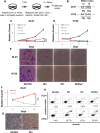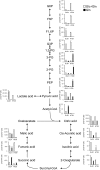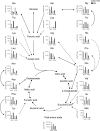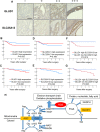Metabolic Adaptation to Nutritional Stress in Human Colorectal Cancer
- PMID: 27924922
- PMCID: PMC5141444
- DOI: 10.1038/srep38415
Metabolic Adaptation to Nutritional Stress in Human Colorectal Cancer
Abstract
Tumor cells respond to their microenvironment, which can include hypoxia and malnutrition, and adapt their metabolism to survive and grow. Some oncogenes are associated with cancer metabolism via regulation of the related enzymes or transporters. However, the importance of metabolism and precise metabolic effects of oncogenes in colorectal cancer remain unclear. We found that colorectal cancer cells survived under the condition of glucose depletion, and their resistance to such conditions depended on genomic alterations rather than on KRAS mutation alone. Metabolomic analysis demonstrated that those cells maintained tricarboxylic acid cycle activity and ATP production under such conditions. Furthermore, we identified pivotal roles of GLUD1 and SLC25A13 in nutritional stress. GLUD1 and SLC25A13 were associated with tumor aggressiveness and poorer prognosis of colorectal cancer. In conclusion, GLUD1 and SLC25A13 may serve as new targets in treating refractory colorectal cancer which survive in malnutritional microenvironments.
Conflict of interest statement
Institutional endowments were partly received from Taiho Pharmaceutical Co., Ltd. (http://www.taiho.co.jp/english/), the Evidence Based Medical (EBM) Research Center (http://ebmrce.co.jp/index.html), Chugai Co., Ltd. (http://www.chugai-pharm.co.jp/english/index.html), Yakult Honsha Co., Ltd. (http://www.yakult.co.jp/english/index.html), and Merck Co., Ltd. (http://www.merck.co.jp/en/index.html). Those funders had no role in the main experimental equipment, supply expenses, study design, data collection and analysis, decision to publish, or preparation of the manuscript for this work.
Figures






Similar articles
-
SLC25A22 Promotes Proliferation and Survival of Colorectal Cancer Cells With KRAS Mutations and Xenograft Tumor Progression in Mice via Intracellular Synthesis of Aspartate.Gastroenterology. 2016 Nov;151(5):945-960.e6. doi: 10.1053/j.gastro.2016.07.011. Epub 2016 Jul 21. Gastroenterology. 2016. PMID: 27451147
-
Prognostic significance of alterations in KRAS isoforms KRAS-4A/4B and KRAS mutations in colorectal carcinoma.J Pathol. 2009 Dec;219(4):435-45. doi: 10.1002/path.2625. J Pathol. 2009. PMID: 19824059
-
RAS status in Korean patients with stage III and IV colorectal cancer.Clin Transl Oncol. 2015 Sep;17(9):751-6. doi: 10.1007/s12094-015-1301-3. Epub 2015 May 22. Clin Transl Oncol. 2015. PMID: 25997687 Clinical Trial.
-
P21WAF1/CIP1 expression in colorectal carcinomas is related to Kras mutations and prognosis.Eur J Gastroenterol Hepatol. 2007 Oct;19(10):883-9. doi: 10.1097/MEG.0b013e3282e1c5f3. Eur J Gastroenterol Hepatol. 2007. PMID: 17873613
-
Discordance of KRAS mutational status in a single colonic resection specimen in a patient with colorectal cancer: a case report and review of the literature.Clin Colorectal Cancer. 2013 Sep;12(3):214-7. doi: 10.1016/j.clcc.2013.04.003. Epub 2013 Jun 4. Clin Colorectal Cancer. 2013. PMID: 23755925 Review. No abstract available.
Cited by
-
Lifting the veil on tumor metabolism: A GDH1-focused perspective.iScience. 2025 May 3;28(6):112551. doi: 10.1016/j.isci.2025.112551. eCollection 2025 Jun 20. iScience. 2025. PMID: 40487432 Free PMC article. Review.
-
Cancer Therapeutic Potential and Prognostic Value of the SLC25 Mitochondrial Carrier Family: A Review.Cancer Control. 2024 Jan-Dec;31:10732748241287905. doi: 10.1177/10732748241287905. Cancer Control. 2024. PMID: 39313442 Free PMC article. Review.
-
Clinical Role of ASCT2 (SLC1A5) in KRAS-Mutated Colorectal Cancer.Int J Mol Sci. 2017 Jul 27;18(8):1632. doi: 10.3390/ijms18081632. Int J Mol Sci. 2017. PMID: 28749408 Free PMC article.
-
Mechanistic Foundations of KRAS-Driven Tumor Ecosystems: Integrating Crosstalk among Immune, Metabolic, Microbial, and Stromal Microenvironment.Adv Sci (Weinh). 2025 Aug;12(30):e02714. doi: 10.1002/advs.202502714. Epub 2025 Jun 9. Adv Sci (Weinh). 2025. PMID: 40485603 Free PMC article. Review.
-
Metabolic networks in mutant KRAS-driven tumours: tissue specificities and the microenvironment.Nat Rev Cancer. 2021 Aug;21(8):510-525. doi: 10.1038/s41568-021-00375-9. Epub 2021 Jul 9. Nat Rev Cancer. 2021. PMID: 34244683 Free PMC article. Review.
References
-
- Brown J. M. & Giaccia A. J. The unique physiology of solid tumors: opportunities (and problems) for cancer therapy. Cancer Res 58, 1408–1416 (1998). - PubMed
-
- Dasu A., Toma-Dasu I. & Karlsson M. Theoretical simulation of tumour oxygenation and results from acute and chronic hypoxia. Phys Med Biol 48, 2829–2842 (2003). - PubMed
Publication types
MeSH terms
Substances
LinkOut - more resources
Full Text Sources
Other Literature Sources
Medical
Research Materials
Miscellaneous

